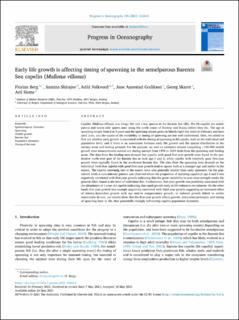| dc.contributor.author | Berg, Florian | |
| dc.contributor.author | Shirajee, Samina | |
| dc.contributor.author | Folkvord, Arild | |
| dc.contributor.author | Godiksen, Jane Aanestad | |
| dc.contributor.author | Skaret, Georg | |
| dc.contributor.author | Slotte, Aril | |
| dc.date.accessioned | 2021-10-08T06:45:01Z | |
| dc.date.available | 2021-10-08T06:45:01Z | |
| dc.date.created | 2021-07-29T23:17:12Z | |
| dc.date.issued | 2021 | |
| dc.identifier.issn | 0079-6611 | |
| dc.identifier.uri | https://hdl.handle.net/11250/2788566 | |
| dc.description.abstract | Capelin (Mallotus villosus) is a forage fish and a key species in the Barents Sea (BS). The BS capelin are semelparous and hence only spawn once along the north coasts of Norway and Russia before they die. The age at spawning ranges from 2 to 5 years and the spawning season peaks in March/April but starts in February and lasts until June, and the causes of the variability in timing of spawning are not well understood. Here, we aimed to find out whether early growth is associated with the timing of spawning in BS capelin, both on the individual and population level, and if there is an association between early life growth and the spatial distribution at the nursery areas and feeding grounds. For the analysis, we used an extensive dataset comprising >150 000 otolith growth zone measurements carried out during surveys from 1976 to 2019 both from the spawning and feeding areas. The data from the feeding area showed that capelin with good first-year growth were found in the productive north-west part of the Barents Sea at both age 1 and 2, while capelin with relatively poor first-year growth were typically found in the south-east Barents Sea. The data from the spawning area showed on the individual level that capelin with good first-year growth tend to spawn both at a younger age and earlier in the season. The capelin spawning late in the season were also generally smaller than early spawners. On the population level, a contradictory pattern was observed where the proportion of maturing capelin at age 2 and 3 was negatively correlated with first-year growth indicating that the great variability in year-class strength masks the general effect found at the level of individual fish. Furthermore, first-year growth was positively associated with the abundance of 1-year-old capelin indicating that rapid growth early in life enhances recruitment. On the other hand, first-year growth was strongly negatively correlated with third-year growth suggesting an increased effect of density-dependent growth with age and/or compensatory growth, or reduced growth linked to earlier maturation. In sum, our results show that the first-year growth affects growth, maturation processes, and timing of spawning later in life, thus potentially strongly influencing capelin population dynamics. | en_US |
| dc.language.iso | eng | en_US |
| dc.publisher | Elsevier | en_US |
| dc.rights | Navngivelse 4.0 Internasjonal | * |
| dc.rights.uri | http://creativecommons.org/licenses/by/4.0/deed.no | * |
| dc.title | Early life growth is affecting timing of spawning in the semelparous Barents Sea capelin (Mallotus villosus) | en_US |
| dc.type | Journal article | en_US |
| dc.type | Peer reviewed | en_US |
| dc.description.version | publishedVersion | en_US |
| dc.rights.holder | Copyright 2021 The Author(s) | en_US |
| dc.source.articlenumber | 102614 | en_US |
| cristin.ispublished | true | |
| cristin.fulltext | original | |
| cristin.qualitycode | 1 | |
| dc.identifier.doi | 10.1016/j.pocean.2021.102614 | |
| dc.identifier.cristin | 1923105 | |
| dc.source.journal | Progress in Oceanography | en_US |
| dc.identifier.citation | Progress in Oceanography. 2021, 196, 102614. | en_US |
| dc.source.volume | 196 | en_US |

